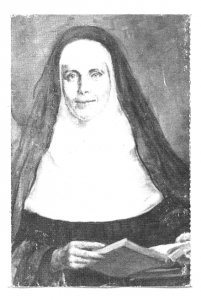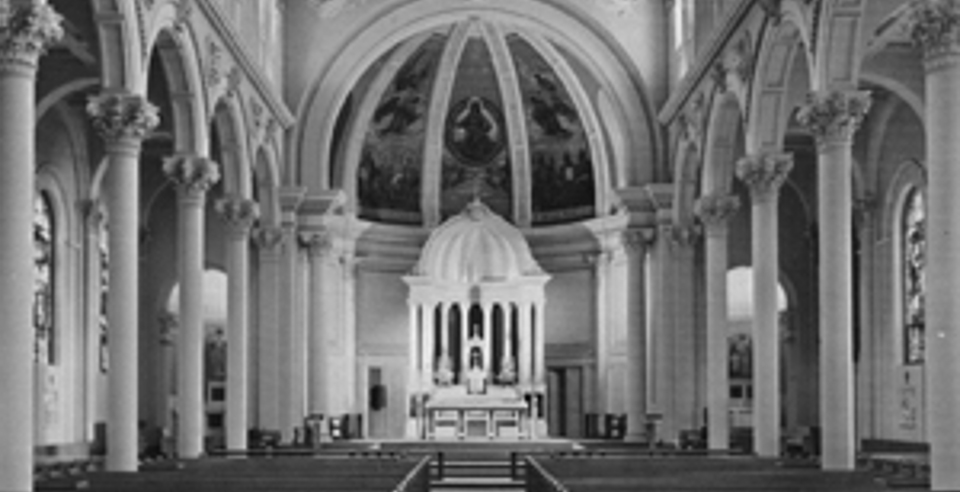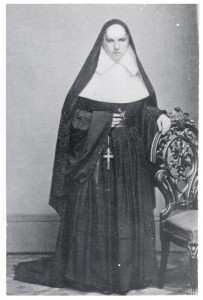
Venerable Catherine McAuley, foundress of the Sisters of Mercy
All tracks:
1. Hail, Virgin of Virgins (solo harp)
2. Introduction / O Dearest Mother Of Mercy
3. Hymn To The Holy Name
4. Ave Verum
5. Jesus, Keep Me Close To Thee
6. Jesus, My Lord, My God, My All
7. O Sacred Heart!
8. My Soul Doth Long For Thee
9. Evening Hymn To Our Lady
10. Ecce Sacerdos Magnus
11. Dear Little One
12. Hail Thou Ever Blessed Morn
13. In Gethsemane
14. Queen Of Heaven, Rejoice
15. To Him Who For Our Sins Was Slain
16. He Is Risen! He Is Risen!
17. Lead, Kindly Light
18. The Day Is Done
1. Hail, Virgin of Virgins (solo harp)
2. Introduction / O Dearest Mother Of Mercy
3. Hymn To The Holy Name
4. Ave Verum
5. Jesus, Keep Me Close To Thee
6. Jesus, My Lord, My God, My All
7. O Sacred Heart!
8. My Soul Doth Long For Thee
9. Evening Hymn To Our Lady
10. Ecce Sacerdos Magnus
11. Dear Little One
12. Hail Thou Ever Blessed Morn
13. In Gethsemane
14. Queen Of Heaven, Rejoice
15. To Him Who For Our Sins Was Slain
16. He Is Risen! He Is Risen!
17. Lead, Kindly Light
18. The Day Is Done
Dorian Concert Choir, Providence, Rhode Island
Jon Carew, conductor
Margaret Day, harp
Edward J. Spargo, narrator
Peter Meggison, producer
Remote recording by Viscount Studios
One of the major contributors to American Catholic music in the late 19th and early 20th centuries was Sister Mary Alexis Donnelly. Born Julia Donnelly of Irish parents in Yorkshire, England, in 1857, she came to the United States as a young girl and entered the Sisters of Mercy at St. Xavier’s Convent, Providence, in 1877. Her early assignments included teaching music in various schools in the Providence Diocese.
Apparently, she was recognized by her superiors as an extremely gifted musician for at the age of 34, in 1891, she published her first hymnal. Sister Mary Alexis titled the compilation Holy Face Hymnal, in recognition of her devotion to the Holy Face of Jesus. The first three hymns in the collection are specifically dedicated to the Holy Face. The hymnal was published by J. Fischer & Bro. of New York, a leading publisher of church music for many years. The hymnal, consisting of 121 pieces, presents “a collection of original and selected hymns…for the use of juvenile choirs, sodalities, congregations, colleges, academies, etc.” Attesting to the popularity of the hymnal are the letters of commendation found at the beginning of subsequent printings of the hymnal. These words of praise include comments from users throughout the United States. A complete version of the Holy Face Hymnal may be viewed on the web at archive.org.
After the Holy Face Hymnal was published, Sister Mary Alexis continued to write hymns which were published in song sheet form including “Immaculata Conceptio,” “Ave Maria,” “Quid Retribuam Domino,” and “O Jesu Deus Magne,” published by Oliver Ditson Company, a music publisher with offices in major cities in the United States. These full-length compositions exemplified her mastery of technique, beauty of expression, and harmonization.
In 1899 the second hymnal compiled by Sister Mary Alexis was published under the title Our Lady of Mercy Hymnal. Originally published by the Providence Sisters of Mercy, the copyright was transferred to J. Fisher & Bro. in order to achieve a wider circulation. This hymnal contains 58 selections–“a collection of hymns and litanies for use at May Devotions, Sodalities, etc.” In the same year that the hymnal was published, Pope Leo XIII consecrated the world to the Sacred Heart; thus, Sacred Heart hymns were in demand and several fine hymns to the Sacred Heart are found among the contents of this publication. Other selections include hymns to the Blessed Sacrament and many for particular feasts and titles of the Blessed Virgin Mary. The first hymn in the series, “Sweet Lady of the Isle,” written while Sister Mary Alexis was assigned to St. Mary’s Parish in Newport, Rhode Island, honors the parish and its namesake. “Hark! now we hear the surging of the waves…Thy watchful care we now implore” aptly convey the composer’s prayerful intentions in harmonic eloquence. Our Lady of Mercy Hymnal, like its predecessor, Holy Face Hymnal enjoyed several printings and was widely used throughout America for most of the 20th Century.
The Catholic Music Publishing Company was founded by James M. McLaughlin and James A. Reilly in Boston in 1904. Almost immediately after its founding, the company became known as McLaughlin & Reilly Company and was the leading distributor of Catholic Church music in America for nearly three-quarters of a century. Sister Mary Alexis had close associations with the company’s president, James A. Reilly, who was a benefactor of the Sisters of Mercy. The company had thousands of musical selections in its catalog, and those by Sister Mary Alexis were featured from the start. These consisted of so-called hymn pamphlets because each pamphlet comprised a selection of various hymns appropriate for a particular occasion or use.
These included:
No. 17 – Four Hymns for Children’s Mass
No. 20 – Hymns for Advent and Christmas
No. 22 – Hymns for Benediction
No. 23 – Hymns to the Sacred Heart
No. 25 – Hymns to the Blessed Virgin Mary
No. 26 – Hymns for Lent
No. 27 – Lead, Kindly Light (dedicated to Rt. Rev. William Stang, Bishop of Fall River)
No. 29 – Hymns to the Blessed Sacrament
No. 31 – Hymns for Easter
No. 17 – Four Hymns for Children’s Mass
No. 20 – Hymns for Advent and Christmas
No. 22 – Hymns for Benediction
No. 23 – Hymns to the Sacred Heart
No. 25 – Hymns to the Blessed Virgin Mary
No. 26 – Hymns for Lent
No. 27 – Lead, Kindly Light (dedicated to Rt. Rev. William Stang, Bishop of Fall River)
No. 29 – Hymns to the Blessed Sacrament
No. 31 – Hymns for Easter
McLaughlin & Reilly marketed these nine hymn pamphlets extensively throughout the company’s existence. Promotional pieces for this series can be found on the back covers of Masses, various hymns, and in other hymnals published by McLaughlin & Reilly. An advertising piece, circulated as late as 1969, indicates that No. 31 contains “the two favorite Easter hymns of Catholic school children.” (i.e., “To Him Who for Our Sins was Slain,” and “He is Risen! He is Risen!”) It is no wonder, then, why these hymns enjoyed such popularity.
Sister Mary Alexis served as Reverend Mother of the Providence Community of the Sisters of Mercy from 1910 to 1916 during which time she acquired the Fiske Estate which was to become the Mt. St. Rita property. In 1912 Mother Alexis composed “God Save All Here—Erin’s Greeting” and dedicated it to the Ancient Order of Hibernians and its Ladies Auxiliary. Proceeds from the sale of this glorious piece—priced at 50 cents—were to be used for the acquisition of the Mt. St. Rita property. During this time, a hymn to St. Rita was composed using the melody of the hymn, “Prayer to St. Ignatius,” found in the Holy Face Hymnal.
Two secular pieces were composed by Mother Alexis during this time period which were widely used at school recessionals, special concerts, and other occasions: “Break, Break, Break” (1914) a poem by Alfred Lord Tennyson and “The Day is Done” (1918) by Henry Wadsworth Longfellow. For the latter, she received a letter of gratitude from Longfellow’s daughter.
Following her term of office, Mother Alexis lived at St. Edward’s Parish, Providence, where she taught music and continued to write a large number of hymns. These hymns, originally published as separate hymns or in pamphlet form for the use of Catholic schools, were to become the nucleus of Our Lady of Mercy Hymnal, Volume II, published in 1927 by the Sisters of Mercy, Providence, R.I. A hymn to St. Theresa, canonized in 1925, “Little Flower of Jesus,” is among its contents. Also included is “Te Saeculorum Principem,” a hymn for the Feast of Christ the King, which was also instituted in 1925. The melodies for some of the more popular hymns from the first volume of Our Lady of Mercy Hymnal are also included and a third verse was added to the hymn, “My Soul Doth Long for Thee,” a testament to its popularity. In the foreword to this edition, Mother Alexis states, “These sacred selections were chosen because experience has proved that the best way to inspire youthful minds with the truths of our holy religion is to have them sing these truths.” She further explains:
In presenting Volume II of Our Lady of Mercy Hymnal, our fervent prayer is that it may draw the hearts of our children to know the tenderness of Our Blessed Mother’s love, that love which all must possess who would enter into the Sacred Heart of Mary’s Divine Son, Jesus Our Lord.
It is known that the hymns of Mother Alexis were widely used among parish choirs and Catholic school children in the Diocese of Providence and Fall River as well as throughout the United States since her music had such great appeal. Several widely used hymnals used selections from the works of Mother Alexis in their contents. The preface of most popular Catholic hymnal in the United States for the first half of the 20th century, St. Basil’s Hymnal, states, “For permission to use copyright tunes we are indebted to the proprietors of the…Our Lady of Mercy Hymnal.” Another popular hymnal, The Mount Mary Hymnal, compiled by a School Sister of Notre Dame of Milwaukee, contains Mother Alexis’, “Jesus, Keep Me Close to Thee.” Appropriately, this hymn, which was the favorite of Mother Alexis herself, was sung at her funeral Mass at SS. Peter and Paul Cathedral, Providence, in 1936. The hymn’s refrain, “All through life and at its closing, Jesus, keep me close to Thee,” is especially suitable as someone enters eternal life.
Prior to Vatican II, it was common practice in religious institutes to refrain from using specific names of vowed men and women in their published works. Therefore, with one exception, no reference can be found to the actual composer of these hymns, Sister (Mother) Mary Alexis Donnelly. Anonymity is assured through references such as “By a Member of the Order of Mercy,” “S. of M.” or “Words and Music by Sisters of Mercy.” The one exception is a full-page advertisement for “English Hymns by a Sister of Mercy” on the last page of The Standard Catholic Hymnal, published by McLaughlin & Reilly in 1921, a popular hymnal which contains Mother Alexis’ “Hail Virgin of Virgins” and “Jesus, Keep Me Close to Thee.” The nine “hymn pamphlets” listed earlier are included in the advertisement, with prices ranging from eight to twelve cents each. For No. 27, “Lead Kindly Light,” “Sr. Alexis” is listed next to the name of the hymn.
We know, therefore, that Mother Alexis was, in fact, the composer of the melodies for all of the hymns that have been referenced in these publications. But did she, too, write the words for these hymns? Many of the words to the hymns Mother Alexis set to her own melodies were authored by well-known Catholic writers of the 19th century including Fathers Frederick Faber (e.g., “Jesus, My Lord, My God, My All;” “Dear Little One;” etc.) and Edward Caswall (e.g., “Hail, Thou Ever Blessed Morn;” “This is the Image of Our Queen”), both converts and contemporaries of recently canonized John Cardinal Newman in the Oxford Movement, as well as Eleanor C. Donnelly (“O Virgin Mother, Lady of Good Counsel;” “O Sacred Heart, O Sacred Heart, So Humble and So Meek”). For many other hymns, such as the favorite of school children during the May procession, “Again, We Greet Our Mother,” the caption indicates “Words and Music by Sisters of Mercy.” So, did Mother Alexis, in addition to writing the music for these hymns, also compose their words? This caption, with the plural used for Sisters, seems to indicate that the words may have been composed by other Sisters, although this information shall forever remain unknown, with one exception. This exception is the last hymn composed by Mother Alexis, “For All Rhode Island’s Sons,” which was a poem authored by Sister Mary Louise O’Brien, for the tercentenary of the State of Rhode Island (1936).
Mother Alexis’ dying request was that her hymns continue to be promulgated; many have attempted to do this even in contemporary times. In 1990 “Mercy’s Music Heritage,” a cassette consisting of 18 hymns composed by Mother Alexis, was recorded by the renowned Dorian Concert Choir of Providence under the direction of the late Jon Carew. The hymns have since been made available by the producer in CD format and may be obtained by emailing the author at pmeggison@aol.com. In addition, these hymns, as well as others, may be heard on the web at this site, www.catholicdevotionalhymns.com. A second volume of “Mercy’s Music Heritage” is currently in the formative stages and will be available later in 2014. This edition will be sung by various choirs and performers.
We do not deny that the words to many of the hymns Mother Alexis composed speak of another age—a simpler, less sophisticated time perhaps. Yet, the hymns still can speak to anyone brought up with them or anyone else who would care to listen since these are the people Mother Alexis served and loved during her lifetime. And, by her song, we remember this great composer for her humble, fervent, sincere, and selfless life which was surrounded by an atmosphere of leadership and inspiration for the good.
–Peter Meggison
Back to Home


